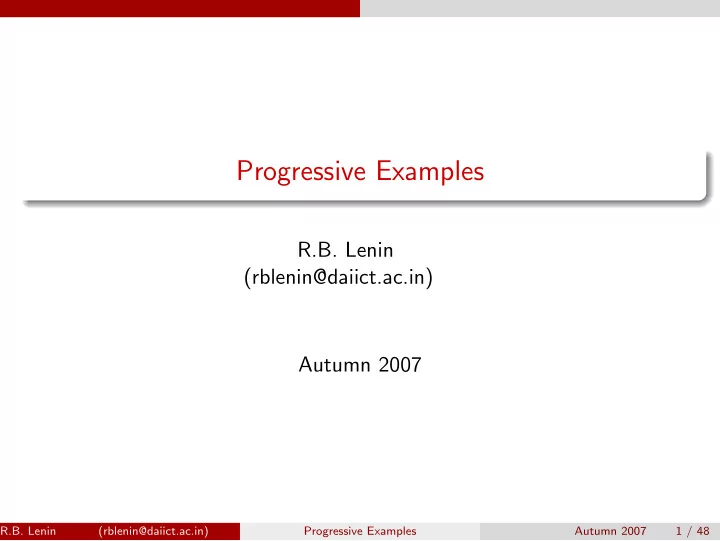

Progressive Examples R.B. Lenin (rblenin@daiict.ac.in) Autumn 2007 R.B. Lenin (rblenin@daiict.ac.in) () Progressive Examples Autumn 2007 1 / 48
Outline Time Advance Mechanism 1 Concepts in Discrete Event Simulation 2 Basic Approaches for Constructing Discrete-Event Simulation Models 3 Prototypical Event-Scheduling Approach 4 Examples 5 Harbour problem Phone problem Camera shop problem Single-stage production system R.B. Lenin (rblenin@daiict.ac.in) () Progressive Examples Autumn 2007 2 / 48
Time Advance Mechanism Time Advance Mechanism Synchronous simulation Look at regular time points 0 , ∆ , 2∆ , . . . , . In continuous systems, it may be necessary to take very small ∆. Asynchronous simulation Jump from one event to the next and describe the changes in state at these moments. We will concentrate on asynchronous simulation of discrete-event system. R.B. Lenin (rblenin@daiict.ac.in) () Progressive Examples Autumn 2007 3 / 48
Concepts in Discrete Event Simulation Concepts in Discrete Event Simulation Entity: Any object or component in the system which requires explicit representation in the model a server, a customer, a machine. Attributes: The properties of a given entity. the priority of a waiting customer, the routing of a job. List: A collection of associated entities, ordered in some logical fashion. all arriving customers are ordered in the queue by FCFS or by priority. An instantaneous occurrence that changes the state of a Event: system. an arrival of a new customer to a system. R.B. Lenin (rblenin@daiict.ac.in) () Progressive Examples Autumn 2007 4 / 48
Concepts in Discrete Event Simulation Concepts in Discrete Event Simulation · · · A record of an event to occur at the current or some Event notice: future time, along with any associated data necessary to execute the event. At a minimum, the record includes the event type and the event time. Event list: A list of event notices to occur in the future, ordered by time of occurrence. It is also known as Future Event List (FEL). Activity: A duration of time of specified length which is usually known when it begins. a service time or inter-arrival time. Delay: A duration of time of unspecified indefinite length which is not known until it ends. a customer’s delay in a LCFS waiting line depends on future arrivals. R.B. Lenin (rblenin@daiict.ac.in) () Progressive Examples Autumn 2007 5 / 48
Concepts in Discrete Event Simulation Concepts in Discrete Event Simulation · · · The state as a function of time is called the sample Sample paths: path. A variable representing simulation time. Clock: R.B. Lenin (rblenin@daiict.ac.in) () Progressive Examples Autumn 2007 6 / 48
Basic Approaches for Constructing Discrete-Event Simulation Models Basic Approaches for Constructing Discrete-Event Simulation Models Event-scheduling approach. Focuses on events, i.e., the moments in time when state changes occur. Process-interaction approach. Focuses on processes, i.e., the flow of each entity through the system. In general-purpose languages, one mostly uses the event-scheduling approach. R.B. Lenin (rblenin@daiict.ac.in) () Progressive Examples Autumn 2007 7 / 48
Recommend
More recommend